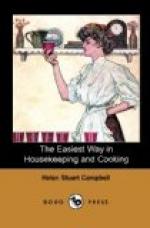Split large soft crackers, what is called the “Boston cracker” being best; butter them well as for eating; lay the buttered halves in baking-pans, and brown in a quick oven. Good at any meal.
SOUR BREAD.
If, by any mishap, bread has soured a little, make into water toast or brewis, adding a teaspoonful of soda to the water or milk.
TO USE DRY BREAD.
Brown in the oven every scrap that is left, seeing that it does not scorch. Roll while hot and crisp, and sift, using the fine crumbs for croquettes, &c., and the coarser ones for puddings and pancakes. Keep dry in glass jars; or tin cans will answer.
BREAD PANCAKES.
One cup of coarse crumbs, soaked over-night in a quart of warm milk, or milk and water. In the morning mash fine, and run through a sieve. Add three eggs well beaten, half a cup of flour, a large spoonful of sugar, a teaspoonful of salt, and, if liked, a little nutmeg. If the bread was in the least sour, add a teaspoonful of soda dissolved in a little warm water. Bake like pancakes, but more slowly.
TO FRESHEN STALE BREAD OR ROLLS.
Wrap in a cloth, and steam for ten or fifteen minutes in a steamer. Then dry in the oven. Rolls or biscuits may have the top crust wet with a little melted butter, and then brown a minute after steaming.
* * * * *
CAKE.
CAKE-MAKING.
In all cake-making, see that every thing is ready to your hand,—pans buttered, or papered if necessary; flour sifted; all spices and other materials on your working-table; and the fire in good order.
No matter how plain the cake, there is a certain order in mixing, which, if followed, produces the best result from the materials used; and this order is easily reduced to rules.
First, always cream the butter; that is, stir it till light and creamy. If very cold, heat the bowl a little, but never enough to melt, only to soften the butter. Second, add the sugar to the butter, and mix thoroughly.
Third, if eggs are used, beat yolks and whites separately for a delicate cake; add yolks to sugar and butter, and beat together a minute. For a plain cake, beat yolks and whites together (a Dover egg-beater doing this better than any thing else can), and add to butter and sugar.
Fourth, if milk is used, add this.
Fifth, stir in the measure of flour little by little, and beat smooth.
Flavoring may be added at any time. If dry spices are used, mix them with the sugar. Always sift baking powder with the flour. If soda and cream of tartar are used, sift the cream of tartar with the flour, and dissolve the soda in a little milk or warm water. For very delicate cakes, powdered sugar is best. For gingerbreads and small cakes or cookies, light brown answers.




